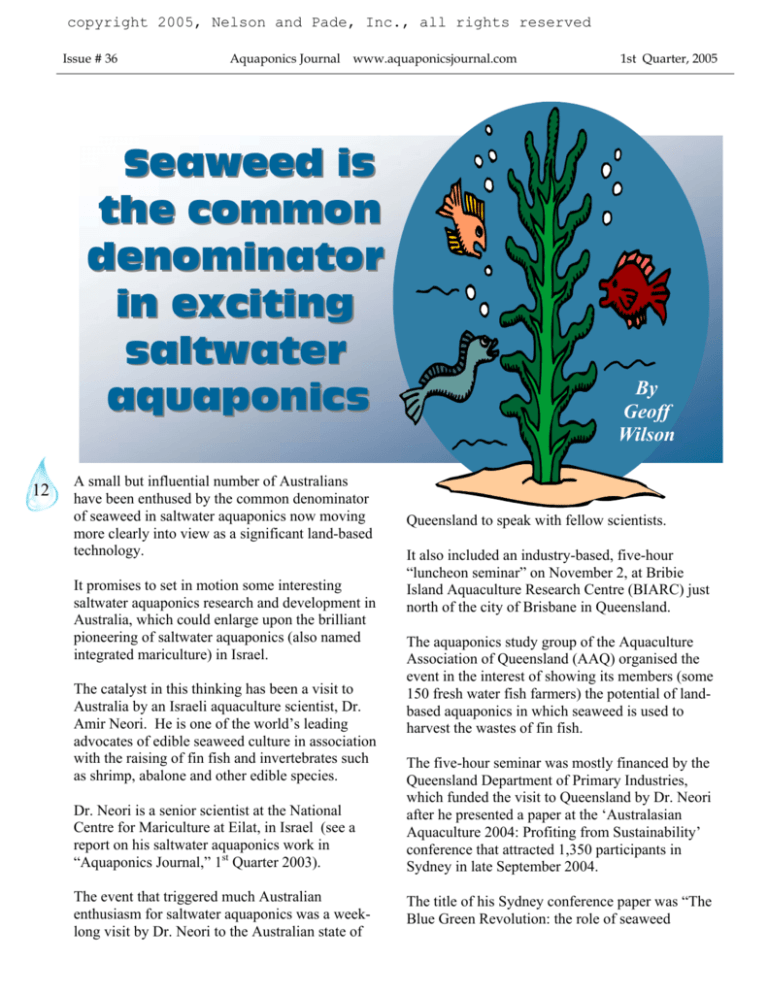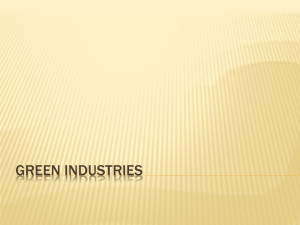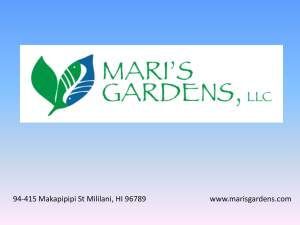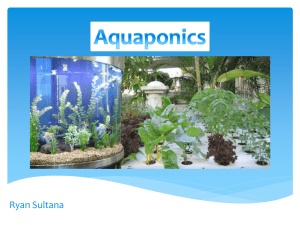
copyright 2005, Nelson and Pade, Inc., all rights reserved
Issue # 36
Aquaponics Journal www.aquaponicsjournal.com
Seaweed is
the common
denominator
in exciting
saltwater
aquaponics
12
A small but influential number of Australians
have been enthused by the common denominator
of seaweed in saltwater aquaponics now moving
more clearly into view as a significant land-based
technology.
It promises to set in motion some interesting
saltwater aquaponics research and development in
Australia, which could enlarge upon the brilliant
pioneering of saltwater aquaponics (also named
integrated mariculture) in Israel.
The catalyst in this thinking has been a visit to
Australia by an Israeli aquaculture scientist, Dr.
Amir Neori. He is one of the world’s leading
advocates of edible seaweed culture in association
with the raising of fin fish and invertebrates such
as shrimp, abalone and other edible species.
Dr. Neori is a senior scientist at the National
Centre for Mariculture at Eilat, in Israel (see a
report on his saltwater aquaponics work in
“Aquaponics Journal,” 1st Quarter 2003).
The event that triggered much Australian
enthusiasm for saltwater aquaponics was a weeklong visit by Dr. Neori to the Australian state of
1st Quarter, 2005
By
Geoff
Wilson
Queensland to speak with fellow scientists.
It also included an industry-based, five-hour
“luncheon seminar” on November 2, at Bribie
Island Aquaculture Research Centre (BIARC) just
north of the city of Brisbane in Queensland.
The aquaponics study group of the Aquaculture
Association of Queensland (AAQ) organised the
event in the interest of showing its members (some
150 fresh water fish farmers) the potential of landbased aquaponics in which seaweed is used to
harvest the wastes of fin fish.
The five-hour seminar was mostly financed by the
Queensland Department of Primary Industries,
which funded the visit to Queensland by Dr. Neori
after he presented a paper at the ‘Australasian
Aquaculture 2004: Profiting from Sustainability’
conference that attracted 1,350 participants in
Sydney in late September 2004.
The title of his Sydney conference paper was “The
Blue Green Revolution: the role of seaweed
Issue # 36
Aquaponics Journal www.aquaponicsjournal.com
cultivation in a sustainable seafood industry.” He
enlarged considerably upon this theme at BIARC
on November 2 – pointing out seaweed culture in
some parts of the world was already considerable.
In China, for example, some seven millions ton of
edible seaweed was produced along its coasts for
human food, livestock fodder and for soil fertiliser.
“Most people do not realize that seaweed and
shellfish, not fin fish, are by far the biggest
elements of the
world’s marine
aquaculture
industry,” he
said.
1st Quarter, 2005
the production of 10 tons of fin fish in seawater
piped from the sea to shore-based operations were
now producing 40 to 80 tons of edible seaweed
from the fish wastes which, in turn, was growing 4
to 8 tons of abalone.
That edible seaweed could then be used to grow
molluscs or other valuable food crops (one ton of
abalone for every two tons of fin fish producing
the wastes) or the seaweed could be used for either
human foods that replaced salad vegetables or for
domestic livestock fodders and soil fertilisers.
Dr. Neori
explained that a
big advantage of
such an
aquaponic
An important
system was that
point was that
many seaweeds
an edible
produce the
seaweed crop
most valuable
for whatever
omega-3 oil. It is
use, could be
probable that
grown for sale
seaweeds can
in six weeks
therefore replace
instead of six
fish oil in diets
At the Sydney conference in September, from left, Dale Young, from GHD, Ausmonths or more
for fish and
tralia’s largest professional services company involved in many aquaculture profor fin fish and
humans to better
jects, Dr. Amir Neori, from Israel’s National Center for Mariculture and Profescrustaceans and
sor Rocky de Nys, a marine biologist from James Cook University in Queensland. balance with the
up to six years
Dr. Neori visited James Cook University in early November to see its work with
omega-6 oil
for abalone.
prawn and reef fish aquaculture.
content that has
become out of
But of very real commercial interest is that many
balance with the needs of human nutrition. It is
successive cash crops of seaweed could be grown
now dawning on the world’s nutritionists that
in conjunction with the farming of fin fish,
omega-3 oils from sea vegetables and fish will
crustaceans and molluscs in one farm. The role of
play a vital role in future human health.
the seaweed in commercial aquaculture was the
same as in nature – the uptake of organic wastes
This simple fact has enormous implications for the
that would otherwise pollute water. Seaweed is
global change to aquaponic food production
nature’s nutrient capture system.
systems that are not only kinder to the
Dr. Neori said the wastes of every ton of fin fish
could produce up to seven tons of plant material
such as lettuce in fresh water aquaponics and
edible seaweed in salt water aquaponics.
In pilot commercial
operations in Israel
environment but are also healthier for humans.
Will we see aquaponic farms in the future based
on seaweed production? The answer appears to be
a resounding ”yes” because it makes such
economic, environmental and human health sense.
“Seaweed is nature’s nutrient capture system.”
13
Issue # 36
Aquaponics Journal www.aquaponicsjournal.com
But worse is to come. By
2050, Dr Allen said, the
area of Australia affected
by salt water problems
was estimated to rise to
some 12 million hectares.
In Australia, Dr. Neori’s
technological advances
come at a crucial time.
Another notable scientist,
Dr. Geoff Allen, past
president of the World
Aquaculture Society, is
leading the inland saltwater
project that involves five
state governments and the
Australian federal
government. He and a most
impressive team of other
Australian aquaculture
researchers are currently
completing research and
development that promises
to make Australia a world
leader in environmentallyfriendly land-based
aquaculture and aquaponics.
14
Dr. Allen told the Sydney
aquaculture conference last
September that currently
about 2.5 million hectares of
Australia’s cultivated land
was badly affected by salt
problems caused by poor
irrigation drainage and
increased cyclic salt salinity
caused by over-clearing of
trees in a fragile
environment.
Harvesting algae by hand. In some parts of the world the
major livelihood of some hundreds of thousands families
is seaweed cultivation.
Acadian Sea Plants, Nova Scotia, Canada, land-based
seaplant cultivation. All natural pink, green and bright
yellow algae are produced and sold to Japanese market.
Algal culture allows
the sustained
development of
aquaculture, because
it is friendly to:
Marine Eco-Systems
Coastal Eco-Systems
Society
Health
Economy
1st Quarter, 2005
Integrated abalone and seaweed farms in South Africa
Sadly, rising saline
groundwater would
adversely affect 74 rural
and metropolitan towns
and cities in Australia.
Dr. Allen said that the
inland saline water project
had already identified 11
potential sites where
salted waters had potential
for sustainable
aquaculture investment.
Such investment could be
“industrial-scale”
aquaculture that allowed
economical infrastructure
development in
processing and marketing.
Mulloway and snapper,
two popular Australian
sea fish species, have been
tested successfully on
these inland waters. So
have prawns.
The promise of edible
seaweed in the equation
has yet to be tested. But if
Dr. Neori’s successful
saltwater aquaponics work
in Israel (and his possible
work at BIARC)
influences the research
budgets of Australia’s
Fisheries Research and
Development Corporation
(FRDC), then Australia
could take a world lead in
commercial saltwater
aquaponics.
Issue # 36
Aquaponics Journal www.aquaponicsjournal.com
1st Quarter, 2005
Dr. Allen said that the challenge in Australia was
to develop a scale of aquaculture investment based
on inland saline waters that would make it
economic and sustainable.
1. Many of Australia’s aquifers of
ancient seawater that could be tapped
for surface ponding and the growing
of sea species of fish, crustaceans
and molluscs.
The challenge that now appears to be just as
2. Saline farm dams and waterways that
important is the aquaponics that
could have floating units
takes the fin fish and prawn
“I believe expanding that keep fish in flexible
wastes from inland saline
plastic containers from
use of such a nonaquaculture investment and does
which wastes can be
polluting aquaponic
something with them in providing
harvested for land-based
other revenue streams – in edible
system using perhaps production of halophytic
seaweeds and other crustaceans
the world’s most plenti- crops.
and molluscs.
3. The Australian long
ful resource – seawater coastline with access to
However, there are problems to
– is likely to be the ma- seawater that can be brought
solve in aquaponics for a
shore-based aquaponics
jor paradigm shift in to
predicted massive expansion of
of the Israeli style. An
humankind’s food pro- estimated 20,000 kilometres
Australia’s inland saline
aquaculture.
duction this century.” of coastal seawater await
tapping by on-shore
One pointed out by scientist Dr.
aquaponic investors.
Stewart Fielder to the Sydney conference in
15
September was that Australian saline waters from
Like many other countries, Australia has had
irrigation and land clearing problems was variable
problems with protests about sea cage aquaculture.
in quality and pond operations using it faced great
temperature variation – from 10 degrees Celsius
It can be intrusive into tourist and fishing recreation
overnight to 30 degrees Celsius during the day.
areas and is not allowed in offshore national parks,
such as Australia’s massive Great Barrier Reef.
But this was not so for some inland saltwater
Rightly or wrongly, pollution of the seabed by fish
resources, notably:
wastes from sea cages is also criticised by
environmentalists.
Fish meal alternatives are a part of the exciting story
One of the major criticisms of world aquaculture is that it is heavily dependent on fish meal and fish oil
from a declining wild catch. That criticism is starting to be answered in Australia in three ways:
1. By developing fish feeds based on grain legumes that displace most, if not all, of the wildcaught products.
2. By developing alternative plant proteins such as edible seaweed and high-protein duck weed
that can be pelleted.
3. By developing aquaponic systems in which wastes from fish and crustacean farms can grow
edible seaweeds on substrates that can be grazed by estuarine mullet or rabbit fish – each of
which can be fed to more valuable species.
Further work will be needed on seaweed and duck weed as successful ingredients of commercial
fish pellets so vital to low-cost, mechanised feeding of fin fish.
Issue # 36
Aquaponics Journal www.aquaponicsjournal.com
But if a pipeline from the sea takes in pristine
seawater to a pond or raceway aquaponic system, it
avoids completely all the objections of tourism
promoters, recreational or commercial fish catchers,
yacht or motor boat enthusiasts or noisy
environmentalists.
The aquaponic technology pioneered by Dr. Neori and
his associates at Eilat uses that piped-in seawater to
grow, in succession, fin fish, seaweed and molluscs
and crustaceans. The small quantities of water
coming from the enterprise back into the sea can be as
pristine as it went in. Only the dissolved sea salt
balance has been altered slightly as water evaporated
while fish, seaweed, molluscs and crustaceans have
used up such things as calcium, phosphorus and micro
nutrients.
16
I believe expanding use of such a non-polluting
aquaponic system using perhaps the world’s most
plentiful resource – seawater – is likely to be the
major paradigm shift in humankind’s food production
this century.
The Israeli system has the big advantage of being able
to locate close to many major coastal cities in the
world.
1st Quarter, 2005
Dr. Neori points out that the aquaponic or
integrated mariculture system he and his team are
developing in Israel is probably best suited to
coastlines where land a short way inland is cheap
and inexpensive labor is plentiful. That surely
describes many countries of the less-developed
world where food and job security have been
inadequate.
Little wonder then that the farsighted sponsorship
of Dr. Neori’s visit to the Bribie Island
Aquaculture Center by the Queensland Department
of Primary Industries and Fisheries, is creating
some excitement. So it is his intention to have a
year-long sabbatical in Australia to work on
saltwater aquaponics with Bribie’s aquaculture
scientists.
Stay tuned for further developments.
About the Author: Geoff Wilson is an agrojournalist based in Queensland, Australia. He is a
regular contributing author to Aquaponics Journal
and can be reached by email at
geoff@nettworx.info or by phone +61 7
3411 4524.
Aquaponics Journal
Shirts and Hats
Shirts:
Stone-washed, Blue Denim, Long sleeve, AJ logo above left chest
pocket. Medium, Large, X-lg . . . $ 24.95
Heavy weight Natural Denim (off-white), long sleeve, aqua AJ
logo above left chest pocket. Medium, Large, X-lg . . . $ 34.95
Baseball Cap:
Two-tone tan/ivy pigment dyed cap with aqua AJ logo on front
$12.95
To order, call 209-742-6869
Or visit www.aquaponics.com







